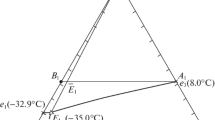Abstract
Using the Picker flow microcalorimeter, excess heat capacities have been obtained at 25°C throughout the concentration range for 2,2-dimethylbutane,n-hexane, and cyclohexane each mixed with a series of hexadecane isomers of increasing degrees of orientational order, as determined by depolarized Rayleigh scattering. The isomers are 2,2,4,4,6,8,8-heptamethylnonane, 6-, 4-, and 2-methylpentadecane, andn-hexadecane. Thec E p values are negative, increasing rapidly in magnitude with increase of orientational order, and are not predicted by the Prigogine—Flory theory which neglects order. Values ofc E p are obtained at 10, 25, and 55°C for cyclohexane +6-, 4-, and 2-methylpentadecane which with other literature data lead to the temperature dependence of the thermodynamic excess functions for cyclohexane solutions of the five C16 isomers. The excess enthalpy and entropy vary with the C16 isomer and with temperature, but the corresponding variation of the excess free energy is small, indicating a high degree of enthalpy-entropy compensation. This is consistent with a rapid decrease with temperature of orientational order in the C16 isomers.
Similar content being viewed by others
References
P. Bothorel,J. Colloid Interface Sci. 27, 529 (1968)
P. Tancrède, D. Patterson, and P. Bothorel,J. Chem. Soc. Faraday Trans. 2 73, 29 (1977).
M. Barbe and D. Patterson,J. Phys. Chem. 82, 40 (1978).
I. Prigogine (with the collaboration of V. Mathot and A. Bellemans),The Molecular Theory of Solutions (North-Holland Publishing Co., Amsterdam, 1957); P. J. Flory,Discuss. Faraday Soc. 49, 7 (1970).
D. Patterson and M. Barbe,J. Phys. Chem. 80, 2435 (1976).
M. D. Croucher and D. Patterson,J. Chem. Soc. Faraday Trans. 2 71, 985 (1975).
S. N. Bhattacharyya and D. Patterson,J. Phys. Chem. 83, 2979 (1979).
P. Picker, P. A. Leduc, P. R. Philippe, and J. E. Desnoyers,J. Chem. Thermodyn. 3, 631 (1971); J. L. Fortier, G. C., Benson, and P. Picker,J. Chem. Thermodyn. 8, 289 (1976); J. L. Fortier and G. C. Benson,J. Chem. Thermodyn. 8, 411 (1976).
J. T. Bendler,Macromolecules 10, 162 (1977).
G. D. Patterson, A. P. Kennedy, and J. P. Latham,Macromolecules 10, 667 (1977); M. Dettenmaier, S. Fischer, and E. W. Fischer,Prog. Colloid Polym. Sci. 62, 37 (1977).
E. W. Fischer and M. Dettenmaier, to be published.
H. Imura and K. Itano,Chem. Phys. Lett. 17, 111 (1972).
J. T. Bendler,Mol. Cryst. Liq. Cryst. 38, 19 (1977).
H. Travan, to be published.
Author information
Authors and Affiliations
Rights and permissions
About this article
Cite this article
Bhattacharyya, S.N., Patterson, D. Excess heat capacities and orientational order in systems containing hexadecane isomers of different molecular structure. J Solution Chem 9, 247–258 (1980). https://doi.org/10.1007/BF00644550
Received:
Revised:
Issue Date:
DOI: https://doi.org/10.1007/BF00644550




